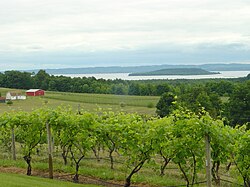Michigan wine
| Wine region | |

A view from Chateau Chantal on Michigan's Old Mission Peninsula
|
|
| Official name | State of Michigan |
|---|---|
| Type | U.S. state |
| Year established | 1837 |
| Years of wine industry | 1933-present |
| Country | United States |
| Sub-regions | Fennville AVA, Lake Michigan Shore AVA, Leelanau Peninsula AVA, Old Mission Peninsula AVA |
| Total area | 97,990 square miles (253,793 km2) |
| Size of planted vineyards | 2,650 acres (1,070 ha) |
| Grapes produced | Baco noir, Cabernet Franc, Cabernet Sauvignon, Catawba, Cayuga, Chambourcin, Chancellor, Chardonnay, Concord, Gamay noir, Gewürztraminer, Kerner, Lemberger, Leon Millot, Marechal Foch, Merlot, Niagara, Pinot blanc, Pinot gris, Pinot noir, Riesling, Sauvignon blanc, Seyval blanc, Syrah, Traminette, Valiant, Vidal blanc, Vignoles |
| No. of wineries | 101 |
Michigan wine refers to any wine that is made in the U.S. state of Michigan. As of 2013, there were 2,650 acres (1,070 ha) under wine-grape cultivation and 101 commercial wineries in Michigan, producing 1.3 million US gallons (4,900,000 L) of wine. According to another count there were 112 operating wineries in Michigan in 2007.
Wine and enotourism were estimated in 2007 to be a $300 million industry. Most of the quality bottled wine of Michigan is produced in the four American Viticultural Areas (AVAs) of Fennville AVA, Lake Michigan Shore AVA, Leelanau Peninsula AVA, and the Old Mission Peninsula AVA. There are also a few wineries in every region of the state including some in the Upper Peninsula that have opened over the past several years.
In addition to grape wine, Michigan is a leader in the production of fruit wines such as cherry wine.
The traditional wines of Michigan were sweet wines, often made from grape varieties native to North America, such as the Catawba, Concord, and Niagara, or from hybrid grapes partly developed by crossing native species with vinifera grapes. North American native grapes have the advantage of being adapted to local growing conditions, with consequent high fruit yield. In addition, growers can switch back and forth between the production of sweet wine and grape juice. Of Michigan's 14,600 acres (5,900 ha) under grape cultivation, only 12%, 1,800 acres (730 ha), were devoted to wine grapes as of 2007.
Michigan's wine industry dates from after the repeal of Prohibition. With large plantings of Concord in the southwest, mostly for the Welch Grape Juice Company, the state was well positioned to enter wine production. Four large wineries (out of eleven wineries established by 1946) came to produce almost all Michigan wine: La Salle Wine and Champagne Company which was established in Windsor, Ontario, and moved to Farmington, Michigan; the Bronte Champagne and Wines Company of Hartford; Michigan Wineries (now Tabor Hill Winery) of Buchanan; and St. Julian Winery, which was also established in Windsor, Ontario, on the Canadian shore across from Detroit during Prohibition and moved to Paw Paw, Michigan, after repeal.
...
Wikipedia
